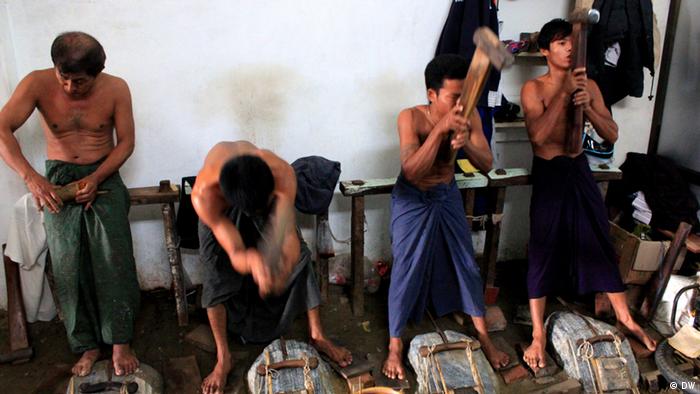
Their work is monotonous, back-breaking and devastating to the
health. But young men in Myanmar take pride in carrying on the tradition
of gold pounding.
Drops of sweat glisten on Thant Myint Ti's forehead as he heaves a
giant hammer and pounds it down. His muscles flex under the strain. He
has already been working for five hours today pounding gold in Mandalay.
"It is really back-breaking work. It takes a lot of muscle power," he explains, leaning back, exhausted. Thant Myint Ti has been a gold pounder for 15 years. The rhythmic, monotonous pounding can be heard in front of the shop and echoes throughout the neighborhood of Myat Par Yat.
There are around 50 traditional family businesses that produce fine leaf gold. They range from smaller operations to larger companies, like Cho Soe Win's, which was founded by her grandfather and has been in her family now for over 100 years.
Traditional craftsmanship
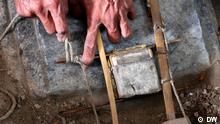 Placing the gold before hammering
Placing the gold before hammering
Now nearly 100 people work for Cho Soe Win. In the shop the gold
pounders stand closely together - bare-chested, lean, muscular bodies
slightly bent over, slowly pounding out gold wrapped in bamboo paper and
deerskin with three-kilogram (seven-pound) hammers.
"First, the men pound the gold for a half hour, then for an hour and then for five hours on end," Cho Soe Win explains. The methods used to produce gold leaf have hardly changed throughout the centuries. Today, machines can only be used for a few processes. One gram of gold makes 200 thin leaves of gold that are one-thousandth of a millimeter thick - thinner than a stroke of ink on a piece of paper.
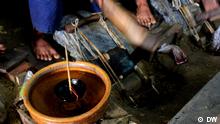 Time is measured in coconuts
Time is measured in coconuts
A traditional water clock tells the men when to rotate duties. It
consists of a coconut shell in a pot of water. The shell has a small
hole in it and when it fills up with water and sinks, one hour is up.
After an hour of monotonous hammering, they get a 15-minute break.
Retired at 45
Thant Myint Ti sits in the sun in front of the shop chewing on a beetle nut. His teeth are stained red from the nuts, but they help him to relax, he says. The 31-year-old has chronic back pain. "The back suffers the most from this job. In the evening, I use traditional medicine to treat the pain," he explains.
Most men start working as gold pounders at the age of 16, after six months of training. After around 10 years of work, most gold pounders get bad backs. Forty-five is the usual cut-off age, after which the body can take no more. "But there is one 60-year-old who still works with us," Thant Myint Ti says.
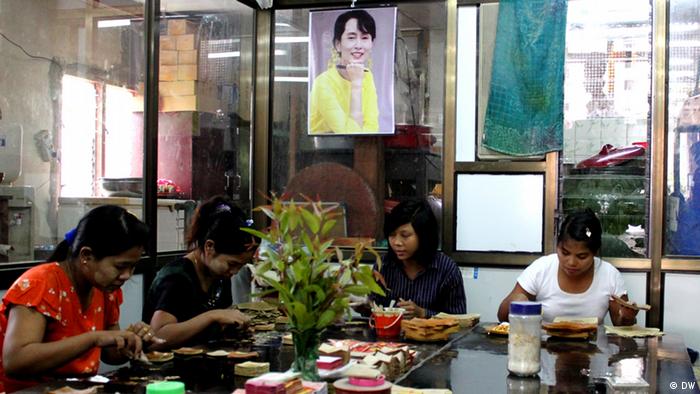 Women cut the gold leaf for sale
Women cut the gold leaf for sale
While the men do the back-breaking pounding, women carry out the
second step in the production process. They sit in a wind-protected room
around short tables and cut the fine leaves of gold.
"It has to be completely protected from wind, otherwise the gold would blow away or get damaged," Cho Soe Win explains. The drone of the pounding in the background mixes with chattering as the women talk amongst themselves while carefully working on the gold. On the wall, there is a poster of opposition leader Aung San Suu Kyi, who watches over their work.
Gold-plated culture
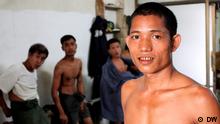 Damage to health is part of the job
Damage to health is part of the job
Than Myint Ti gets up and re-ties his longyi, a traditional Burmese
garment he is wearing around his waist, and goes back to work. "If I had
a son," he says, reaching for his hammer, "I would not want him to
become a gold pounder. It is hard work and it is not good for the body
or spirit."
On the other hand, the job is well paid. The high season is winter. That is when the companies get the most orders. Thant Myint Ti and his colleagues can earn up to 5,000 kyat – slightly less than 5 euros - per day. On average, the daily cost of living in Mandalay is about one euro. Myanmar's average monthly wages are among the lowest in Southeast Asia. Thant Myint Ti is proud of his work - it is a trade that is held in high esteem in the country. The work is even said to be healthy. "The healers say the consumption of gold is good for preventing heart disease. So eating leaf gold is good for the heart," Cho Soe Win explains. People enjoy gold with bananas or honey.
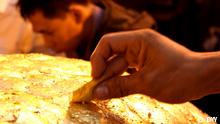 A Buddha statue gradually grows in size, one gold leaf at a time
A Buddha statue gradually grows in size, one gold leaf at a time
But the leaf gold is mainly used in Buddhist temples and pagodas.
Mandalay's Mahamuni Pagoda is a prime example. The fine gold is in high
demand at the pagoda; depending on size, it runs from 300 to 700 kyat -
from 30 to 70 euro cents. Hundreds of Buddhists travel to the pagoda
daily and kneel before the giant golden statue of Buddha to pray. Men
approach the statue and paste on fine leaves of gold. Throughout the
decades so much gold has been pasted on to the statue that in certain
spots it is 35 centimeters thicker. A giant golden Buddha - pounded out
and re-formed by the gold pounders of Mandalay.
Author: Monika Griebeler / sb
Editor: Simon Bone
"It is really back-breaking work. It takes a lot of muscle power," he explains, leaning back, exhausted. Thant Myint Ti has been a gold pounder for 15 years. The rhythmic, monotonous pounding can be heard in front of the shop and echoes throughout the neighborhood of Myat Par Yat.
There are around 50 traditional family businesses that produce fine leaf gold. They range from smaller operations to larger companies, like Cho Soe Win's, which was founded by her grandfather and has been in her family now for over 100 years.
Traditional craftsmanship
 Placing the gold before hammering
Placing the gold before hammering"First, the men pound the gold for a half hour, then for an hour and then for five hours on end," Cho Soe Win explains. The methods used to produce gold leaf have hardly changed throughout the centuries. Today, machines can only be used for a few processes. One gram of gold makes 200 thin leaves of gold that are one-thousandth of a millimeter thick - thinner than a stroke of ink on a piece of paper.
 Time is measured in coconuts
Time is measured in coconutsRetired at 45
Thant Myint Ti sits in the sun in front of the shop chewing on a beetle nut. His teeth are stained red from the nuts, but they help him to relax, he says. The 31-year-old has chronic back pain. "The back suffers the most from this job. In the evening, I use traditional medicine to treat the pain," he explains.
Most men start working as gold pounders at the age of 16, after six months of training. After around 10 years of work, most gold pounders get bad backs. Forty-five is the usual cut-off age, after which the body can take no more. "But there is one 60-year-old who still works with us," Thant Myint Ti says.
 Women cut the gold leaf for sale
Women cut the gold leaf for sale"It has to be completely protected from wind, otherwise the gold would blow away or get damaged," Cho Soe Win explains. The drone of the pounding in the background mixes with chattering as the women talk amongst themselves while carefully working on the gold. On the wall, there is a poster of opposition leader Aung San Suu Kyi, who watches over their work.
Gold-plated culture
 Damage to health is part of the job
Damage to health is part of the jobOn the other hand, the job is well paid. The high season is winter. That is when the companies get the most orders. Thant Myint Ti and his colleagues can earn up to 5,000 kyat – slightly less than 5 euros - per day. On average, the daily cost of living in Mandalay is about one euro. Myanmar's average monthly wages are among the lowest in Southeast Asia. Thant Myint Ti is proud of his work - it is a trade that is held in high esteem in the country. The work is even said to be healthy. "The healers say the consumption of gold is good for preventing heart disease. So eating leaf gold is good for the heart," Cho Soe Win explains. People enjoy gold with bananas or honey.
 A Buddha statue gradually grows in size, one gold leaf at a time
A Buddha statue gradually grows in size, one gold leaf at a timeAuthor: Monika Griebeler / sb
Editor: Simon Bone
緬甸新首都掀開神秘面紗

Luke Duggleby for The Wall Street Journal
週二﹐一位清潔工在緬甸新首都內比都的一家超市外清掃停車位。
緬
甸為打破與外界的堅冰而做出的最新嘗試或許讓人捉摸不透﹐但在參觀完緬甸偏遠而神秘的新首都內比都之後﹐有一點是一目瞭然的﹐那就是:緬甸領導人正在下一盤大棋。近 期在印尼舉行的東南亞國家聯盟(Association of Southeast Asian Nations﹐簡稱:東盟)峰會上﹐東盟十國決定讓緬甸在2014年擔任輪值主席國﹐此項決定對緬甸而言是一件好事﹐它肯定會提高內比都的知名度。緬甸 尋求通過擔任東盟主席國來提升國際聲望﹐作為主席國﹐緬甸要舉辦一系列外交峰會﹐會吸引到數千名外國人到訪內比都。
《華爾街日報》 (Wall Street Journal)記者前段時間跟隨一個政府授權的訪問團參觀了這座嶄新的城市。內比都是在過去十年里建起來的﹐以取代殖民地時期的前首都仰光﹐前些年基本 不讓西方人進入。一名記者兼攝影師在參觀中發現﹐有許多跡象顯示﹐儘管多年來緬甸受到西方嚴厲的經濟制裁﹐但緬甸領導人仍將該國視為亞洲的重要一員﹐並期 望在未來讓緬甸更加開放。
一個能容納大量國際航班的新的大型機場正在建設。政府還在興建兩座體育場﹐用於舉辦地區性體育賽事﹐同時﹐開發商正在興建大型酒店。
記 者參觀了新建的緬甸國際會議中心(Myanmar International Convention Center)﹐這個龐大的會議中心週邊是多片空地﹐是由中國出資援建的。記者還看到一個巨大的穹頂展覽館﹐狀似飛碟﹐和一般的美國大學籃球館差不多大﹐ 用於做國際寶石貿易。由於緬甸人權紀錄不佳﹐美國禁止和緬甸進行寶石貿易﹐但緬甸並未因此停止寶石貿易﹐而是增加了對中國及亞洲其他地區的出口。
從前﹐訪問這座城市的西方記者一般不暴露身份﹐他們要偷拍照片﹐還要保持低調﹐以免被發現甚至遭到驅逐。


Luke Duggleby for The Wall Street journal
緬甸軍政府承諾將放寬之前的強硬路線政策,並爭取擔任2014年東盟輪值主席國。本圖集收集了該國首都內比都的一些照片。圖為位於內比都的歐巴達丹蒂佛塔(Uppatasanti Pagoda)。
在 內比都老機場一座稻田環繞的低矮建築里﹐政府官員迎接了《華爾街日報》記者一行。官員們告訴記者他們有“自由時間”﹐想看什麼都可以。這些親切的向導大體 上履行了承諾﹐帶領記者用好幾個小時來參觀這座據稱佔地幾百平方英里的巨大城市﹐參觀路線包括一座購物中心﹐一些酒店﹐一座大型倉儲超市和一些政府住宅區 (不過沒有參觀議會)。
內比都是一座經過總體規劃的城市﹐劃分成賓館區、住宅區和政務區等不同區域﹐這座城市的氣場把當地居民給震住了。許多人有點茫然不知所措﹐因為內比都太大了﹐而他們則缺少城市生活經歷。長長的馬路上沒有車﹐交通警察站在路邊的樹陰下﹐看著遠方的牛車在犁田。
內比都有一些六車道和八車道公路﹐其中幾條基本是空的﹐只有自行車、摩托車和偶爾駛過的汽車﹐有時就像空盪蕩的閱兵場一樣。這些公路往外延伸出去便是灰白色的土路﹐通往佇立著高腳樓的村莊﹐或者橫穿過稻田。
儘 管緬甸處於赤貧狀態(緬甸是亞洲最貧窮的國家之一)﹐但內比都的十幾個大型交通環島處仍擺放著精心照料的盆花﹐還有景觀草坪﹐有噴水裝置澆灌週邊的綠化 區。內比都的賓館區有大約30個項目﹐其中包括設有67間客房的安國酒店(Hotel Amara)“城市度假村”﹐內有一個可供企業舉行會議的行政樓。
指派給《華爾街日報》記者的向導們在內比都一個主要景點的檢查站被警察攔住﹐告知不允許在該景點拍照﹐這是建在山上的一座金色佛塔﹐可俯瞰內比都全城。不過﹐在與主辦本次活動的政府官員通過電話之後﹐記者一行獲準拍照了。
這是一座壯觀的佛塔﹐供奉著來自中國的神聖佛牙舍利。政府官員拍了些訪問團參觀佛塔的照片﹐第二天有一篇關於記者參觀該景點的短訊刊登在政府喉舌《緬甸新光報》(The New Light of Myanmar)上。一名軍隊准將歡迎記者一行有機會再來。
記者一行還會晤了緬甸信息文化部長以及其他一些官員﹐會面是在一個隱藏於灌木叢和密林中的政府辦公樓里進行的。隨後﹐記者們在專人陪同下回到機場﹐期間在機場附近一個咖啡館短暫停留﹐喝了點蘇打水﹐聊了會兒天。
當 內比都幾年前首次亮相時﹐曾遭國際媒體及許多外國外交官挖苦。外國記者通常將內比都形容為距仰光300公里的“叢林”避難所或“戒備森嚴的深宅大院”。記 者們認為﹐古怪的前軍政府建內比都是出於風水因素﹐或者是為了防範美國──以及緬甸本國人民──入侵﹐據報道稱這裡有一個巨型地堡網絡。大多數外交官拒絕 搬到內比都。

Luke Duggleby for The Wall Street Journal
當地一棟在建酒店。
政 府前規劃人員溫明(Win Myint)曾參與設計內比都﹐現在他在仰光做私人顧問。他說﹐政府領導人十年前開始勾畫內比都建設藍圖時就有一個清晰的願景。他們希望規避亞洲其他首都 面臨的問題﹐比如近鄰曼谷臭名昭著的交通堵塞﹐他們還需要有足夠空間容納多達一百萬居民(目前據信還不到這個數字的一半)。
他說﹐設計人員參觀和研究了其他國家的首都和政府行政中心﹐包括馬來西亞總體規劃的布城(Putrajaya)。布城就在吉隆坡南邊﹐設計人員認為其距吉隆坡這個大城市太近﹐車輛太多。
溫明稱﹐“如果你搞不清楚他們的用意﹐你只能下結論說這些人瘋了。”
他說﹐“當然﹐我們也許也有一些錯誤”﹐但我們為“做出正確決定”付出了努力。
溫明表示﹐華盛頓等城市曾經也是新首都﹔他認為一旦新機場建成﹐入駐內比都的企業增加﹐玉石行業有望得到支持﹐屆時內比都可能會像這些城市一樣發展壯大起來。
政府住宅區附近已經出現了一些戶外咖啡館和路邊攤﹐還有卡拉OK歌廳。
緬甸過去曾經放棄過一些宏偉計劃。緬甸上世紀九十年代啟動改革﹐放鬆國家對經濟的管制之後﹐曾經希望吸引更多遊客﹐並在中部名城曼德勒(Mandalay)建起大型國際機場﹐將其變成國際交通樞紐。
但經濟制裁和其他一些問題使這些計劃夭折了﹐位於曼德勒空曠郊區的機場很大一部分已經廢棄。
內比都也一樣有可能成為一件昂貴的大而無當的擺設。記者採訪了一位到訪內比都的中國外交官﹐他是從仰光過來出差的。他說他覺得內比都比較無聊﹐還有一點讓人摸不著頭腦。他說﹐“你只能待在賓館或者去看佛塔。”
但他補充說﹐“這是一座年輕的城市﹐到處都還在建設﹐也許在十年後它就會變成一座非常大的城市。”
Patrick Barta
Whatever happens with Myanmar's latest tentative thaw with the outside world, one thing is clear after seeing this remote and rarely visited capital: Myanmar's leaders are thinking big.
This may be fortuitous: Thursday's decision at a regional summit in Indonesia to let Myanmar assume the chairmanship of the 10-member Association of Southeast Asian Nations in 2014 all but ensures that Naypyitaw will take on a higher profile. The position, which Myanmar sought as a way to raise its international standing, involves hosting a lengthy series of diplomatic summits and could draw thousands of foreign visitors to the city.
On a government-authorized tour this week of the shiny new city--built over the past decade to replace Myanmar's former colonial-era capital of Yangon, and mostly off-limits to Westerners in previous years--a Wall Street Journal reporter and photographer found numerous signs the country's leaders see Myanmar as a major player in Asia despite years of tough economic sanctions from the West, and expect it to be more open in the years ahead.
A massive new airport is under construction with space to handle rows of international jets. The government is adding two new stadiums to help host regional sporting competitions, while developers are building sprawling new hotel complexes.
There's a gigantic new Myanmar International Convention Center--built next to empty fields, and funded by China--as well as a vast domed exhibition hall that looks like a flying saucer (and is roughly the size of a typical American college basketball arena) for international gem sales. Trade in Myanmar's famous precious stones is blocked in the U.S. because of the country's human-rights record, but that hasn't stopped Myanmar, which just sells more of them to China and other parts of Asia.
Western journalists who visited the city before typically did so undercover, shooting furtive photographs and keeping a low profile to avoid detection and possible deportation.
The Wall Street Journal visit on Tuesday, however, was approved by authorities after they agreed to a request from the newspaper to interview government officials about the country's latest overhaul process, which has included relaxations on the media and the release of hundreds of political prisoners after decades of harsh military rule.
The Wall Street Journal journalists were picked up by government employees at the city's current airport, in a low-slung building surrounded by rice paddies, and told they had 'free time' and could see whatever they wanted. For the most part, the cheerful guides made good on their promise, providing a multihour tour of the vast city--which reportedly spreads over hundreds of square miles--that included stops at a shopping mall, some hotels, a 'big box' hypermarket and a series of government apartment blocks, though not the parliament.
The sweep of the master-planned city, which is divided into different zones for hotels, residences and government buildings, dwarfs its inhabitants, many of whom seemed a bit bewildered by its size and lack of street life. Traffic police stood under the shade of trees along long roads with no traffic, watching ox carts poke by in fields in the distance.
Several of the six- and eight-lane highways were largely empty except for bicycles, motorbikes and occasional cars, at times resembling empty parade grounds. Chalky dirt roads radiate out from the highways, leading to villages of stilt houses or across rice fields.
Despite the country's crushing poverty--it is one of the poorest in Asia--the city's dozen or so giant roundabouts included neatly-tended potted flowers and landscaped grass, while sprinkler systems watered green areas nearby. The hotel zone included about 30 projects, including a 67-room Hotel Amara 'urban resort,' with an executive wing with space for corporate seminars.
The guides assigned to The Wall Street Journal were stopped by police at a checkpoint for the city's main attraction--a towering golden pagoda on a hill overlooking Naypyitaw--and told cameras were not allowed on the site. But after a phone call to officials sponsoring the visit, the way was cleared.
Government employees took photos of the visitors as they toured the impressive structure, which includes a sacred Buddha tooth relic from China, and a brief account of the reporters' visit to the site appeared the next day in the government mouthpiece, The New Light of Myanmar. A brigadier general encouraged the journalists to return.
After a meeting with the country's information and culture minister and other officials, in a large government block hidden behind scrub and jungle, the reporters were escorted back to the airport, with a brief stop for sodas and conversation at a cafe near the airport.
Naypyitaw was ridiculed by the international media and many foreign diplomats when it was first unveiled a few years ago. It was routinely described as a 'jungle' retreat some 300 kilometers from Yangon or 'fortified compound' by international news reporters, who suggested it was built to satisfy the astrological whims of the country's eccentric former military regime, or to insulate its leaders from a feared American invasion--as well as from its own people--with reports of a vast network of underground bunkers. Most diplomats refused to move there.
But observers of Myanmar affairs have also argued the city was designed by the country's leaders to make a clean break from Yangon's crumbling infrastructure and colonial legacy--it was known as Rangoon to the British--and recast the country in a more modern mold.
Win Myint, a former government planner who helped design the city, and now works as a private consultant in Yangon, said government leaders had a clear vision when they set about conceptualizing Naypyitaw in the early parts of the last decade. They wanted to avoid the ills of other Asian capitals, like the infamous gridlock of nearby Bangkok, and wanted enough room to handle as many as a million inhabitants (it currently is believed to have less than half that).
Designers visited and studied other capitals and government administrative centers, he said, including Malaysia's master-planned Putrajaya just south of Kuala Lumpur, which they concluded was too close to the big city, giving it too much traffic.
'If you have no clue, you just conclude, these people are crazy,' Mr. Win Myint said.
'Of course maybe there were some mistakes, but we tried' to make good decisions, he said.
He said he thinks Naypyitaw will likely grow into its big footprint--as other once-new capitals like Washington did--once the new airport is finished and more businesses move in, possibly to support the jade industry.
A few outdoor cafes and street vendors have popped up near government apartment blocks, along with karaoke bars.
Myanmar has abandoned grand plans before. After launching overhauls in the 1990s to loosen the state's grip over the economy, it sought to encourage more visitors and built a large international airport in Mandalay to turn the fabled central Myanmar city into an international hub.
But economic sanctions and other problems helped kill those schemes, and large portions of the airport in otherwise-empty countryside outside of Mandalay fell into disuse.
Naypyitaw, as well, could turn out to be a giant, and costly, white elephant. One visitor interviewed on Tuesday, a Chinese diplomat who had traveled from Yangon on business, said he thought it was boring and a bit befuddling. 'You just stay at your hotel or go to the pagoda,' he said.
'But it's a young city,' he added. 'There still is construction everywhere-- maybe in ten years, it will be a very big city.'

沒有留言:
張貼留言